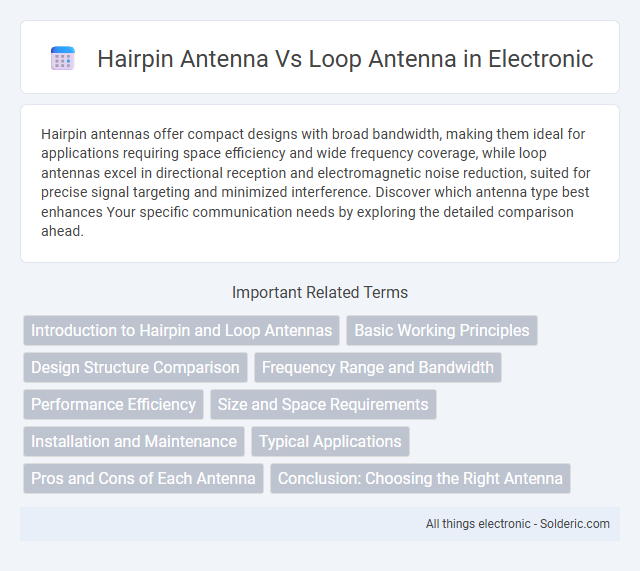Hairpin antennas offer compact designs with broad bandwidth, making them ideal for applications requiring space efficiency and wide frequency coverage, while loop antennas excel in directional reception and electromagnetic noise reduction, suited for precise signal targeting and minimized interference. Discover which antenna type best enhances Your specific communication needs by exploring the detailed comparison ahead.
Comparison Table
| Feature | Hairpin Antenna | Loop Antenna |
|---|---|---|
| Structure | Hairpin-shaped conductive element | Closed loop of conductor (circular, square, or rectangular) |
| Frequency Range | Typically UHF to microwave bands | Low to VHF and sometimes UHF |
| Radiation Pattern | Directional with moderate gain | Mostly omnidirectional or bidirectional |
| Gain | Moderate gain (around 5-8 dBi) | Low to moderate gain (0 to 3 dBi) |
| Polarization | Usually linearly polarized | Can be linear or circular polarization |
| Impedance Matching | Easy to match with 50 ohms by adjusting hairpin length | Challenging; often uses tuning capacitors or matching networks |
| Applications | Wi-Fi, RFID, and microwave communications | AM broadcasting, direction finding, RFID, HF applications |
| Size | Compact for higher frequencies | Typically larger at lower frequencies |
| Bandwidth | Relatively broad bandwidth | Narrow bandwidth, dependent on loop size |
Introduction to Hairpin and Loop Antennas
Hairpin antennas, known for their folded structure, provide a compact design with improved impedance matching for higher frequency applications, often used in VHF and UHF bands. Loop antennas, characterized by their circular or square shape, excel in magnetic field reception and transmission, making them ideal for direction finding and low-frequency communication. Your choice between the two depends on the specific frequency range, size constraints, and application requirements of your antenna system.
Basic Working Principles
A hairpin antenna operates by using a U-shaped element acting as a resonator to match impedance and enhance bandwidth, typically connected to the feedline at one end while the other end is short-circuited. In contrast, a loop antenna consists of a closed conducting loop that induces voltage through magnetic field coupling, functioning primarily as a magnetic dipole with distinct resonance characteristics depending on the loop size relative to the wavelength. The hairpin antenna's design emphasizes compactness and impedance matching, whereas the loop antenna focuses on magnetic field reception and directional properties.
Design Structure Comparison
The hairpin antenna features a U-shaped design, consisting of two parallel conductive arms connected by a shorting bar, providing a compact and directional radiation pattern suitable for VHF and UHF frequencies. The loop antenna, by contrast, is typically a closed loop of wire or conductor that offers omnidirectional or bidirectional radiation patterns depending on its size and shape, making it ideal for receiving or transmitting at lower frequencies. Understanding the structural differences between the hairpin's folded dipole form and the loop's enclosed geometry helps you select the best antenna design for your specific bandwidth and spatial requirements.
Frequency Range and Bandwidth
Hairpin antennas typically operate in higher frequency ranges, often suited for VHF and UHF applications, providing narrower bandwidths optimized for specific channels. Loop antennas cover a broader frequency range, including low-frequency and HF bands, delivering wider bandwidths and improved multi-band performance. You should choose a hairpin antenna for targeted, high-frequency use and a loop antenna for versatile frequency coverage and broader bandwidth needs.
Performance Efficiency
Hairpin antennas deliver higher performance efficiency in applications requiring narrow bandwidth and high gain, making them ideal for VHF and UHF communications. Loop antennas offer superior efficiency at low frequencies, exhibiting lower noise and better signal-to-noise ratio due to their magnetic field sensitivity. Your choice depends on the frequency range and gain requirements, ensuring optimal antenna efficiency for your specific communication needs.
Size and Space Requirements
Hairpin antennas are more compact and require less space compared to loop antennas, making them ideal for installations with strict size constraints. Loop antennas typically have larger physical dimensions to achieve the same operating frequency, which can be challenging in confined areas. Your choice should consider available space and the desired antenna performance for optimal results.
Installation and Maintenance
Hairpin antennas offer simpler installation due to their compact, rigid design, which requires minimal mounting hardware and precise alignment. Loop antennas often demand careful positioning and tensioning of the loop wire or elements, increasing installation complexity and maintenance efforts. Maintenance for hairpin antennas is generally less frequent and easier, while loop antennas may require regular inspections for wire integrity and tension adjustments to ensure optimal performance.
Typical Applications
Hairpin antennas are commonly used in VHF and UHF communication systems due to their compact size and ease of tuning, making them ideal for television reception and portable radio devices. Loop antennas excel in direction finding, RFID systems, and magnetic field measurements because of their sensitivity to magnetic flux and ability to reject electric noise. When selecting an antenna for your project, consider that hairpin antennas suit broad, high-frequency applications, whereas loop antennas are preferred for precise directional and low-frequency tasks.
Pros and Cons of Each Antenna
Hairpin antennas offer a compact design with broad bandwidth and ease of tuning, making them ideal for applications requiring a stable and adjustable resonant frequency. However, they tend to have lower radiation efficiency and narrower impedance matching compared to loop antennas. Loop antennas provide higher efficiency, better noise immunity, and a more uniform radiation pattern, but they are generally larger and more complex to construct, which may impact your choice based on space and performance requirements.
Conclusion: Choosing the Right Antenna
Choosing the right antenna depends on your specific application, frequency range, and size constraints. Hairpin antennas offer compact size and narrow bandwidth, ideal for VHF and UHF applications, while loop antennas provide broader bandwidth and better noise rejection, suitable for HF frequencies. Your decision should balance these factors to optimize signal performance and antenna efficiency.
hairpin antenna vs loop antenna Infographic

 solderic.com
solderic.com